 CS 660: Combinatorial Algorithms
CS 660: Combinatorial Algorithms
Graphs and Network Flows
[To Lecture Notes Index]
San Diego State University -- This page last updated November 16, 1995

Contents of Graphs and Network Flows Lecture
- Definitions
- Graph
- Digraph
- Subgraph
- Complete Graph
- Path
- Adjacent Vertices
- Connected Graph
- Cycle
- Simple Cycle
- Weighted Graph
- Representation of Graphs
- List of edges
- Adjacency Matrix
- Adjacency list
- Incidence Matrix
- Traversing Graphs
- Breath-first(Graph, startNode)
- Analysis of Breath-First Search
- Depth-first(Graph, startNode)
- Network Flow
- The Max-flow min-cut theorem
A graph G is a pair (V,E) where
- V is a set of vertices (or nodes)
-
- E is a set of edges connecting the vertices
-
EXAMPLE
- V = {1,2,3,4,5}
-
- E = {(1,2), (1,3), (1,4), (1,5), (2,3), (3,4), (4,5),(5,2)}
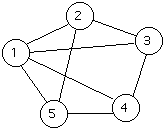
A Digraph is a graph in which each edges has a direction.
EXAMPLE
- V = { 1,2,3,4,5}
-

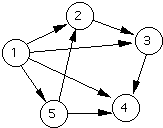
A Subgraph G'= (E',V') of a graph G = (E,V) is a graph where V' is a subset of
V and E' is a subset of E
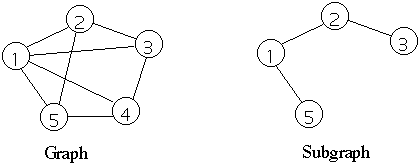
A graph with an edge between each pair of vertices
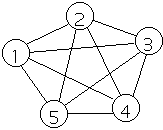
Note for any G = (E,V) we have 0 <= |E| <= |V|*(|V|-1)/2
A path in a graph from vertex V to vertex W is a sequence of edges (V1,V2),
(V2,V3),... (Vk-2,Vk-1), (Vk-1,Vk) such that V = V1, and W = Vk. The path is
usually given as V1,V2,V3,...Vk
The above path has length k.
Two vertices are adjacent if there is an edge connecting them
A graph is connected if there is a path between any two vertices
A path starting and ending on the same vertex
A cycle in which all vertices are visited exactly once except the starting
vertex: which is visited only twice
A weighted graph G = (V,E,W) is a graph where each edge e in E has a weight
denoted by W(e)
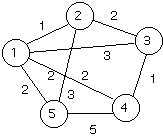
The weight of a Graph is the sum of the weights of the edges of the graph
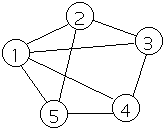
EXAMPLE
- 1, 2
- 1, 3
- 1, 4
- 1, 5
- 2, 3
- 3, 4
- 4, 5
- 5, 2
Space - O(|E|) ( actually 2|E|)

| 1 | 2 | 3 | 4 | 5 |
| 1 | 0 | 1 | 1 | 1 | 1 |
| 2 | 1 | 0 | 1 | 0 | 1 |
| 3 | 1 | 1 | 0 | 1 | 0 |
| 4 | 1 | 0 | 1 | 0 | 1 |
| 5 | 1 | 1 | 0 | 1 | 0 |
Space - O(|V|2) (can be ~ |V|2/2)
For weighted graph

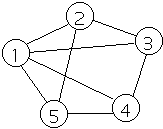
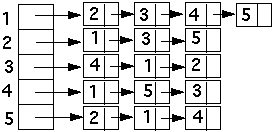
Space - O(|E| + |V|)

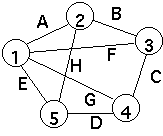
| A | B | C | D | E | F | G | H |
| 1 | 1 | 0 | 0 | 0 | 1 | 1 | 1 | 0 |
| 2 | 1 | 1 | 0 | 0 | 0 | 0 | 0 | 1 |
| 3 | 0 | 1 | 1 | 0 | 0 | 1 | 0 | 0 |
| 4 | 0 | 0 | 1 | 1 | 0 | 0 | 1 | 0 |
| 5 | 0 | 0 | 0 | 1 | 1 | 0 | 0 | 1 |
Space - O(|E|*|V|)
Line number
for X := 1 to |V| do 1
Type[X] := unvisited; 2
Create(Queue); 3
Type[startNode] := inQueue 4
Insert(startNode, Queue); 5
visitOrder := 1; 6
while not IsEmpty(Queue) do 7
nextNode := GetFirst(Queue); 8
List[nextNode] := visitOrder; 9
visitOrder := visitOrder + 1; 10
Type[nextNode] = visited; 11
for each node adjacent to nextNode do 12
if Type[node] = unvisited then 13
Type[node] := inQueue; 14
Insert(node, Queue); 15
end if;
end for;
end while;
return List
Measure of size of input: |E| and |V|
Structures used:
Type
- array of size |V|
- Each element changed at most three times:
- random -> unvisited -> inQueue -> visited
List
- array of size |V|
- Each element changed once
Queue
- Contains at most |V| - 1 elements
- At most |V| adds and |V| deletes from queue
- At most |V| calls to IsEmpty
VisitOrder
- Increased |V| times
Graph
Must find all neighbors of each node in graph
Adjacency Matrix O(|V|2)
| 1 | 2 | 3 | 4 | 5 |
| 1 | 0 | 1 | 1 | 1 | 1 |
| 2 | 1 | 0 | 1 | 0 | 1 |
| 3 | 1 | 1 | 0 | 1 | 0 |
| 4 | 1 | 0 | 1 | 0 | 1 |
| 5 | 1 | 1 | 0 | 1 | 0 |
Adjacency list O(|E| + |V|)
-
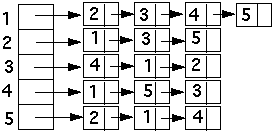
Traversing Graphs
Line number
for X := 1 to |V| do 1
Type[X] := unvisited; 2
Create(Stack); 3
Type[startNode] := inStack; 4
Insert(startNode, Stack); 5
visitOrder := 1; 6
while not IsEmpty(Stack) do 7
nextNode := Pop(Stack); 8
List[nextNode] := visitOrder; 9
visitOrder := visitOrder + 1; 10
Type[nextNode] = visited; 11
for each node adjacent to nextNode do 12
if Type[node] = unvisited then 13
Type[node] := inStack; 14
Push(node, Stack); 15
end if;
end for;
end while;
A flow network G = (V, E) is a directed graph where each edge (u, v)
[[propersubset]] E has a capacity c(u, v) >= 0
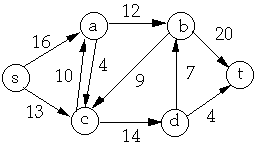 Source
(s) - node with only outflows
Source
(s) - node with only outflows
Sink (t) - node with only inflows
Assume graph is connected
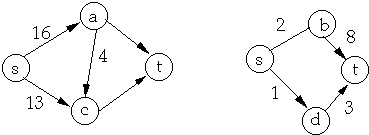
Multiple Sources/Sinks
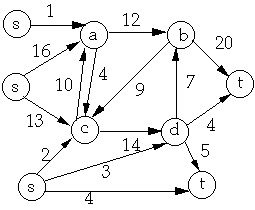 Super Sources and Sinks
Super Sources and Sinks
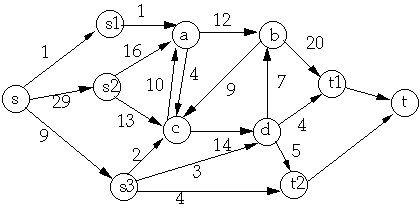
A flow in G is a real-valued function f : V * V -> R such that:
- For all u, v [[propersubset]] V, f(u, v) <= c(u, v) [Capacity
constraint]
-
- For all u, v [[propersubset]] V, f(u, v) = -f(v, u) [Skew symmetry]
-
- For all u [[propersubset]] V - {s, t},
 [Flow conservation]
[Flow conservation]
Value of a flow f is

Positive Net Flow entering vertex v is

Positive Net Flow leaving vertex v is

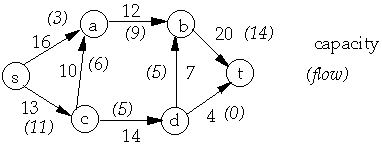
f(a, b) = 9 f(b, a) = -9 c(b, a) = 0 c(a, d) = 0 f(a, d) = 0
Oh Boy More Notation
Implicit Summation Notation
Let
 then
then

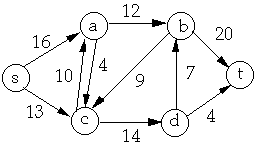
X = {a, c}, Y = {b, d } then
f(X, Y) = f(a, b) + f(a, d) + f(c, b) + f(c, b)
- = 12 + 0 + -9 + 14
-
- = 17
Lemma. Let G = (V, E) be a flow network and f be a flow in G
a. If
 then f(X, X) = 0
then f(X, X) = 0
b. If
 then
f(X, Y) = -f(Y, X)
then
f(X, Y) = -f(Y, X)
c. If
 then
then
-
 and
and
-
-

proof of a
- For all u [[propersubset]] V f(u, u) = 0 since we have f(u, u) = -f(u, u)
-
- We have:
-
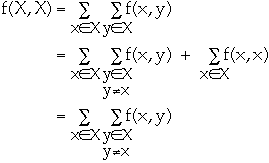
-
- For every term f(x, y) we also have f(y, x)
-
- Since f(x, y) = -f(y, x) we have f(X, X) = 0
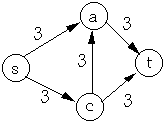
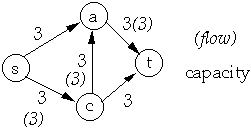
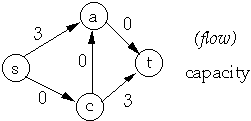
Let G = (V, E) be a flow network and f a flow in G
residual capacity of (u, v) is cf(u, v) = c(u, v) - f(u, v)
residual network of G induced by f is Gf = (V, Ef) where
- Ef = { (u, v) V * V : cf(u, v) > 0}
Residual Network
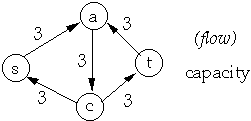
| Network | Flow on Network |
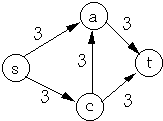 | 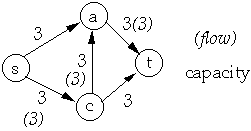 |
| Residual Network | Flow in Residual Network |
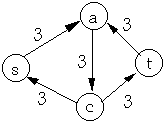 | 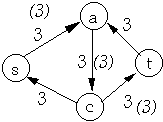 |
Resultant Flow in Original Network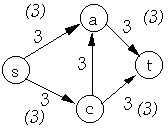
Let G = (V, E) be a flow network and f be a flow in G.
Let Gf = (V, Ef) be the residual network of G induced by f.
Let h be a flow in Gf.
Define f + h to by (f + h )(u, v) = f(u, v) + h(u, v)
Lemma. f + h is a flow in G with value |f + h|= |f|+|h|
proof of Capacity constraint
(f + h )(u, v) = f(u, v) + h(u, v)
= -f(v, u) - h(v, u)
= -(f(v, u) + h(v, u))
= -(f + h )(v, u)
Augmenting Paths
Let G = (V, E) be a flow network and f be a flow in G.
Let Gf = (V, Ef) be the residual network of G induced by f.
An augmenting path p is a simple path from s to t in Gf
Residual capacity of p is the maximum amount of net flow that we can
ship along the edges of p
cf(p) = min { cf(u, v) : (u, v) is on path p}
| Residual Network | Flow in Residual Network |
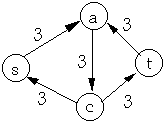 | 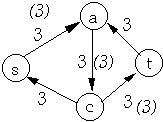 |
Lemma. Let G = (V, E) be a flow network and f be a flow in G.
Let p be an augmenting path in Gf. Define hp : V * V -> R by:
-

Then hp is a flow in Gf with value |hp| = cf(p).
Corollary
Let G = (V, E) be a flow network and f be a flow in G.
Let p be an augmenting path in Gf. Define hp as above.
Let k = f + hp. Then k is a flow in G with value
|k| = |f|+ | hp | > |f|
Ford-Fulkerson Method to find Maximum Flow
Let G = (V, E) be a flow network
initialize flow f to 0
while there exits an augmenting path p
- do add hp to f
return f


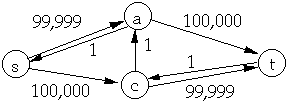
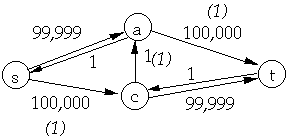
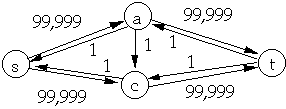
Let G = (V, E) be a flow network and f a flow in G
A cut (S, T) of G is a partition of V into S and T = V - S such that:
- s [[propersubset]] S and t [[propersubset]] T
The net flow across the cut (S, T) is f(S, T)
The capacity of the cut (S, T) is c(S, T)
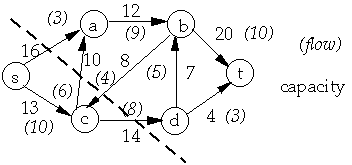
S = {s, c} T = { a, b, d, t}
f(S, T) = 3 + 6 - 4 + 8 = 13
c(S, T) = 16 + 10 + 14
Lemma
Let G = (V, E) be a flow network and f be a flow in G.
Let (S, T) be a cut of G. Then the net flow across (S, T) is
- f(S, T) = |f|
proof:
- f(S, T)
- = f(S, V - S)
- = f(S, V - S)
-
- = f(S, V) - f(S, S)
-
- = f(S, V)
-
- = f(s, V) + f(S - s, V)
-
- = f(s, V)
-
- = |f|
Corollary The value of any flow f in a flow network G is bounded from
above by the capacity of any cut of G
Let f be a flow in G = (V, E) be a flow network with source s and sink
t.
The following are equivalent:
1. f is a maximum flow in G
2. The residual network Gf contains no augmenting paths
3. |f| = c(S, T) for some cut (S, T) of G.
Ford-Fulkerson Algorithm to find Maximum Flow
Let G = (V, E) be a flow network
for each edge (u, v) [[propersubset]] E do
- f[u, v] = 0
- f[v, u] = 0
while there exits a path p from s to t in residual network Gf do
- do cf(p) = min { cf(u, v) : (u, v) is on path p}
- for each edge (u, v) in p
- do
- f[u, v] = f[u, v] + cf(p)
-
-
- f[u, v] = -f[v, u]
return f
How long does it take?
Edmonds-Karp Algorithm
Find shortest path from s to t in Ford-Fulkerson
Let G = (V, E) be a flow network and f be a flow in G.
Let Gf = (V, Ef) be the residual network of G induced by f.
Let p be shortest path from s to t in Gf.
Define the flow
-

Let df(x, y) be the shortest-path distance from x to y in Gf
Let dh(x, y) be the shortest-path distance from x to y in Gh
Lemma 27.8 For all v [[propersubset]] V - {s, t} we have df(s, v) <= dh(s,
v)
proof:
- Assume that there exists v such that df(s, v) > dh(s, v)
-
- Let v be the closes vertex to s for which this is true
-
- Let sp be the shortest path from s to v in Gf
-
- Let u be the vertex before v on sp and f[u, v] < c(u,v) then
-
- df(s, v)
- = df(s, u) + 1
- <= dh(s, u) + 1
-
- = dh(s, v)
- So we must have f[u, v] = c(u, v)
-
- Thus (u, v) is not in Ef which means (v, u) is in Ef
-
- So df(s, u)
- = df(s, v) + 1
-
- df(s, v)
- = df(s, u) - 1
- <= dh(s, u) - 1
- = dh(s, v) - 2
- < dh(s, v)
Theorem The Edmonds-Karp Algorithm will perform at most O(V*E) flow
augmentations.
proof:
- An edge (u, v) in a residual network Gf is critical on an augmenting path
p if the residual capacity of p is the residual capacity of (u, v)
-
- How many times can an edge be critical?
-
-
- We have (draw picture)
- df(s, v)
- = df(s, u) + 1
- dh(s, u)
- = dh(s, v) + 1
-
-
- So dh(s, u)
- = dh(s, v) + 1
- >= df(s, v) + 1
- = df(s, u) + 2
-
- Thus ( u, v) can be critical at most O(V) times
Since there are O(E) edges the total number of critical edges is O(E*V)
 CS 660: Combinatorial Algorithms
CS 660: Combinatorial Algorithms CS 660: Combinatorial Algorithms
CS 660: Combinatorial Algorithms